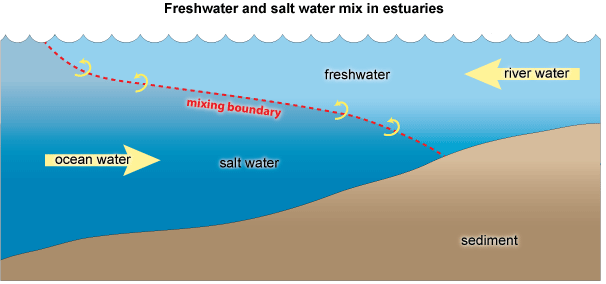How does a coastal ecosystem stay balanced for nutrients and oxygen?
For most coastal ecosystems, nutrients (plant fertilizers like nitrogen and phosphorus) and delivered to an estuary primarily from the adjacent watershed land. Nutrients also enter the coastal waters from rain and dust that falls from the air, and in some cases from the ocean. Most of the nutrients entering the estuary are absorbed by plants, especially floating algae (phytoplankton). These plants use nutrients, along with sunlight,carbon dioxide and water, to create energy for growth of new plant tissue. This process, called photosynthesis, also creates oxygen, but it can only occur in the upper zones of water where there is sufficient light.
Fish and other animals obtain energy by eating the algae while breathing oxygen and giving off carbon dioxide in a process called respiration, which occurs throughout the water. When photosynthesis and respiration are balanced, this leads to a very stable and productive ecological system. When algae, fish and other animals die they sink to the bottom where bacteria decompose their bodies back into nutrients through respiration. Those nutrients are then buried as sediments, released to the atmosphere as gas, or recycled back up into the lighted zones of the water column where they can support more photosynthesis.
How does a coastal ecosystem become unbalanced?
In a balanced ecosystem, bacteria and animals in the sediments and bottom waters can use and decompose this sinking dead organic material without depleting all the oxygen that mixes down from the air to the lower zones of the water. However, when nutrient additions from human activities are excessive the whole system can be set out of balance. For example, high concentrations of nutrients running off from agriculture and urban lands can over-fertilize an estuary, causing large sustained blooms of algae. When the algae die and sink to the bottom, bacteria tend to consume most of the oxygen faster than it is replenished from the overlying air through downward mixing, and the system goes out of balance. When the system is unbalanced for sustained time periods, Dead Zones may be formed.
Why can’t oxygen be replenished?
The physical interaction between fresh river water and ocean salt water affect the circulation and mixing of water in the estuary. The fresh river water flowing from the watershed into the estuary along the top is lighter and less dense, while the salt in seawater makes it more dense (so heavier) as it flows along the bottom from the ocean into the estuary. The generally higher temperature of river water in summer also adds to its lower density and tendency to float on the surface, and this buoyancy is reinforced by the fact that the surface water is further warmed by absorbing more heat from sunlight. This makes the density difference between the upper and lower layers of the water even stronger (increased stratification), further reducing the downward mixing of oxygen to the bottom layer. In the summer the stratification is so strong that oxygen doesn’t get mixed down to the bottom to replenish the oxygen that bacteria are using up while decomposing all of the excessive dead algae. Under these conditions, hypoxia occurs in bottom waters of the estuary. In the fall, when the temperature of surface waters cools rapidly, the surface layer gets more dense, and this, coupled with strong frontal winds, allows the surface and bottom layers to be readily mixed, bringing oxygen down to the bottom waters again.
